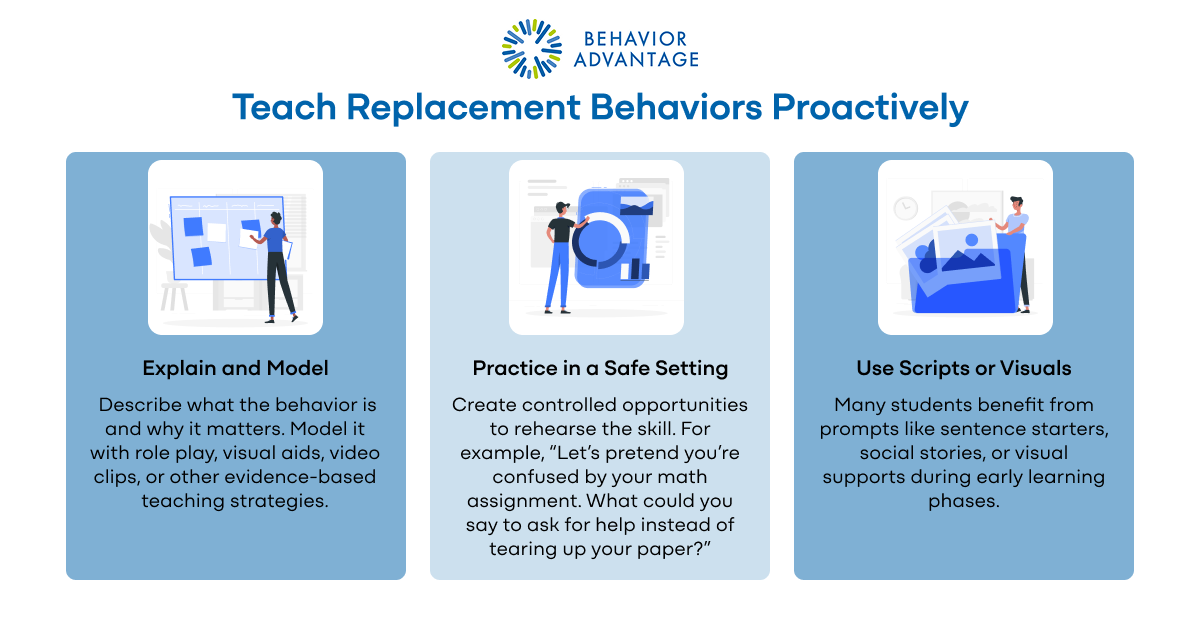Once your team has defined a clear target behavior and selected a functionally aligned replacement behavior, it’s time to bring your Behavior Intervention Plan (BIP) to life. One of the most important sections of any BIP is the Teaching New Skills or Teaching Replacement Behaviors section.
This is where we answer three key questions:
- How will we teach the replacement behavior?
- How will we prompt or remind the student to use it?
- How will we reinforce or motivate the student to practice and keep using it?
Let’s break each of these down using practical, team-friendly language that builds on the replacement behavior examples in our previous blog.
Our team has developed a comprehensive guide about writing BIPs that work, take a look, if you need further advice!
1. Teach Replacement Behaviors Proactively (Tip: Not when the student is misbehaving)
In our last blog, we looked at how to match replacement skills to functions. Telling a student what to do is not the same as teaching them how to do it. If we want new behaviors to replace old ones, we need to create practice opportunities in calm, supportive settings—not wait for a crisis moment to coach in real time.
Start with this sequence:
- Explain and Model – Describe what the behavior is and why it matters. Model it with role play, visual aids, video clips, or other evidence-based teaching strategies.
- Practice in a Safe Setting – Create controlled opportunities to rehearse the skill. For example, “Let’s pretend you’re confused by your math assignment. What could you say to ask for help instead of tearing up your paper?”
- Use Scripts or Visuals – Many students benefit from prompts like sentence starters, social stories, or visual supports during early learning phases.

Example: For a student learning to “take space” when agitated during class, you might model, rehearse, and walk through this routine in the classroom with just the teacher and counselor a few times.
2. Prompt Use of Replacement Behaviors in Context
Even after strong teaching, students will likely need reminders in real-world moments—especially when emotions or triggers are present.
Prompts should:
- Be as least intrusive as possible while still effective.
- Move the student toward independent use of the skill.
- Be adjusted depending on the student’s escalation level.
Prompts can include nonverbal cues like pre-taught gestures, visual supports, simple verbal reminders, and pointing. There are many ways to subtly help remind students to practice pre-taught replacement behaviors.
Be mindful that more direct prompts may be needed when a student is already escalated—but our ultimate goal is to fade prompts over time and build self-regulation.
3. Reinforce Replacement Behaviors to Build Motivation
No matter how well we teach or prompt, students won’t stick with new behaviors unless they’re motivated. Reinforcement is how we make the effort worth it.
As mentioned earlier, there are two main types of replacement behaviors—and each calls for a slightly different reinforcement approach:
A. Functionally Equivalent Behaviors (FERBs)
These serve the same function as the problem behavior.
Tip: The replacement behavior should result in the same payoff the student used to get.
- If yelling got attention, raising a hand should too.
- If eloping led to a break, requesting a break should provide the same escape.
Reinforce immediately and reliably, or the old behavior will return.
B. Alternative or Desired Behaviors
These promote long-term skill development, like perseverance or following directions, even when they don’t offer the same immediate payoff.
Tip: Reinforce with motivators that matter to the student.
This could be:
- Check-In/Check-Out systems
- Verbal specific social acknowledgement
- Class privileges or independence
- Peer interactions or activity choices
- Time with a preferred staff member
- And so much more – be creative!
Reinforcers should be:
- Immediate enough to be effective
- Contingent on the behavior (not given for free)
- Aligned with what motivates the individual student
- Not readily available otherwise and only used to reinforce the desired behavior
Be Consistent: Reinforce the New Behavior, Not the Old One
One final—but essential—piece of teaching replacement behaviors is to make sure we’re no longer reinforcing the old behavior.
This doesn’t mean ignoring the student altogether or using consequences harshly. It simply means being consistent about which behaviors we respond to—and which ones we don’t.
To help the new behavior stick, we must:
- Reinforce the replacement behavior every time it’s used.
- Avoid giving attention or rewards when the old behavior resurfaces.
Example:
A student frequently calls out or becomes disruptive during class to get the teacher’s undivided attention. The team teaches the student to raise their hand and wait to be called on as a replacement behavior.
Now, the teacher consistently responds to hand-raising with praise and attention—but does not respond to blurting out. Instead of reacting to disruptive episodes, the teacher stays calm, keeps teaching, and waits until the student uses the replacement skill and then gives them the attention they’re seeking.
When students see that appropriate behaviors are what get them noticed—and that inappropriate ones don’t lead to the same result—they start shifting their habits. This takes time and consistency, but it’s one of the most powerful ways to support lasting change.
Final Thoughts
Teaching replacement behaviors isn’t just a checkbox in a BIP—it’s the heart of helping students succeed. When we take time to:
- Teach new skills explicitly,
- Prompt them in the moment, and
- Reinforce them meaningfully,
…we empower students to replace problem behaviors with skills that will serve them for years to come.
Need support building effective BIPs and teaching plans? At Behavior Advantage, our platform helps you define, teach, and track replacement behaviors that lead to real change.
Let’s stop guessing—and start teaching behaviors that last.









